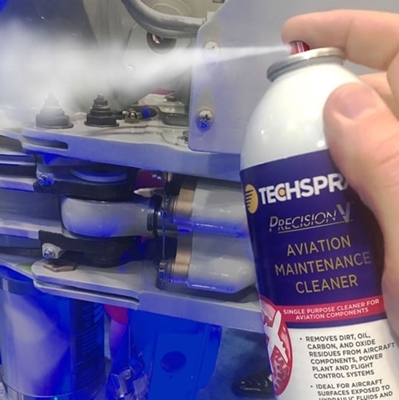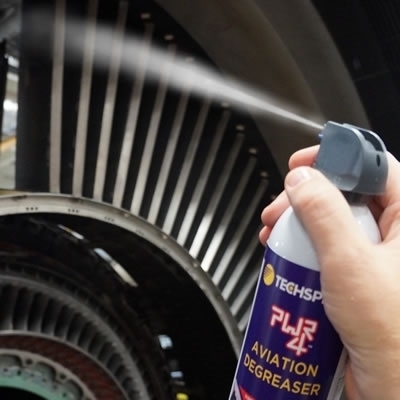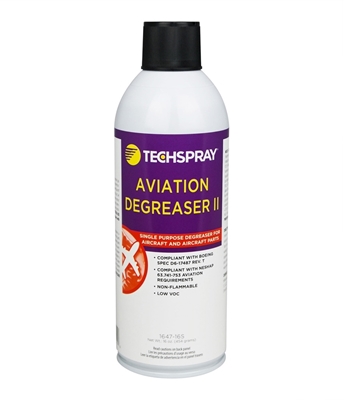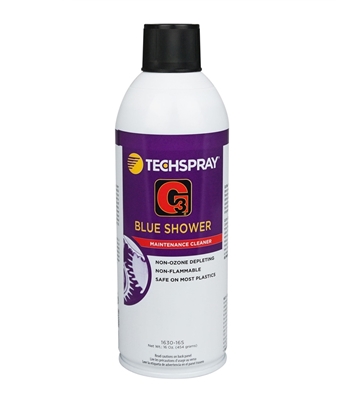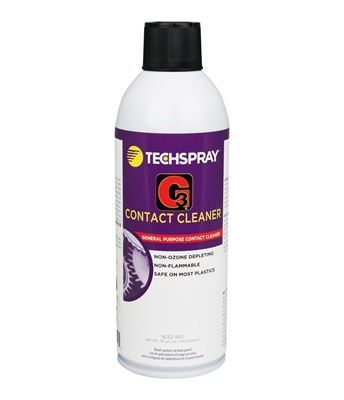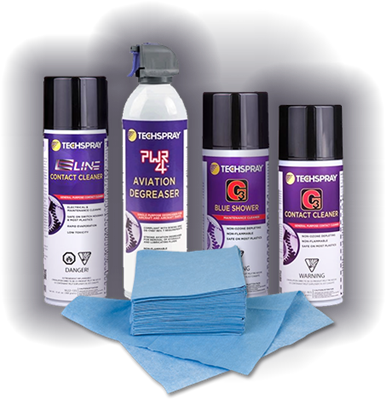Selecting new cleaning chemicals for use in aviation maintenance, repair, and overhaul (MRO) organizations is fraught with risk, given the impacts from an ill-advised choice. The long-term effect on aircraft serviceability and safety, human health, and the environment could prove to be considerable and expensive, with heavy regulatory penalties for transgressions. Having navigated those issues, if the chosen product proves less than efficient at its task, further costs ensue from extended maintenance times, the risk of sub-optimal maintenance, and ongoing cleaning chemical costs.
Given the wide range of cleaning tasks an MRO faces, each cleaning product will offer characteristics more or less suited to a specific task. However, there are seven important characteristics to rank against the intended application and the business location's regulatory requirements.
An easy-to-use qualification worksheet is available, which follows along with the criteria below.
Criteria 1: Aviation Compatibility of a Solvent Degreaser
No worker in the aviation community would knowingly expose aircraft or the traveling public to harm. However, there is more than a moral obligation on those choosing aircraft cleaning chemicals. FAA regulations require chemical agents used on aircraft to comply with tests qualifying the substance for aviation use. While the FAA suggests a range of tests they consider acceptable, the approval of other equivalent tests may be granted upon application to the FAA.
Aircraft manufacturers' maintenance documentation stipulates approved cleaners by name or by noting the standard to which any cleaners must be approved if used on their aircraft. Major aircraft manufacturers have testing standards approved by the FAA, and these will often be the reference quoted in the manuals. Following the manufacturer's recommendation is the safest way for an MRO to ensure regulatory compliance.
When considering a new cleaner for aviation use, it must be certified by the manufacturer to comply with the FAA or manufacturer's qualifying tests or an approved alternative. Be aware that many products will comply with the majority of a particular test but fail in one area. A common example is meeting corrosion tests but failing the acrylic crazing component. The cleaner will still be fine to use, but caution is needed where exposure to acrylic components may occur.
Techspray has created an in-depth look at the FAA's tests required of aircraft cleaners, including a list of the major manufacturer's standards, which you can access here.
Criteria 2: Human Health Effects of an Aviation MRO Degreaser
The late 20th and early 21st centuries have rightly seen increased scrutiny regarding workers' occupational exposure to chemicals. Cleaning products routinely used ingredients effective at their tasks but which have since proven harmful to individual health. Prolonged use of such chemicals can cause life-changing effects to human physiology including death.
The resulting enhanced occupational health and safety oversight has increased compliance costs for businesses. Using harmful chemicals requires a considerable investment in personal protective equipment (PPE), environment management systems, monitoring of employee exposure limits, and the use of registered contractors for disposal. In response, the aviation cleaning chemical industry offers a wide range of worker-friendly products to clients forced to seek more benign alternatives.
When choosing a new cleaning product, businesses should be alert for ingredients that include n-propyl bromide (nPB), methylene chloride, trichloroethylene (TCE), and perchloroethylene (perc).
Many products may still contain these four chemicals; however, if selected for use, the safety compliance and disposal costs experienced by a business can greatly offset their often lower purchase price.
N-propyl bromide is often used in vapor degreasing and metal cleaning products; however, studies have shown nPB to affect the peripheral and central nervous systems while also affecting the blood.[1] For a deeper dive on nPB, Techspray offers this article and this webinar while offering a guide to safe handling.
In August, 2020, in the report “Nontechnical Summary of the Risk Evaluation for 1-Bromopropane (n-Propyl Bromide)”, the US Environmental Protection Agency (EPA) determined that the solvent “presents an unreasonable risk for 16 conditions of use.” Some of those conditions of use include:
- Industrial and consumer use for cleaning and degreasing
- Vapor degreasers – open-top and inline
- Liquid imersion cleaners
- Aerosol spray degreaser/cleaner
- Automotive degreasers -- i.e. for engines, brakes
Methylene chloride is used in many industrial applications, including metal cleaning and degreasing. Considered a potential occupational carcinogen, methylene chloride is toxic to the liver, kidney, and reproductive system. It impacts the nervous system and can cause liver, brain, and lung cancers and non-Hodgkin's lymphoma.[2]
Trichloroethylene is very efficient at dissolving organic materials like fats and greases, making it suitable for cleaning products. However, TCE is considered a possible carcinogen, and studies suggest it may be a factor in birth defects, testicular cancer, leukemia, and lung tumors.[3]
Perchloroethylene is a common ingredient in dry cleaning chemicals and is often used in metal degreasers, and for dewaxing metal prior to plating. Short-term exposure to high levels of perc affects the central nervous system and may lead to unconsciousness and death.[4]
The personal hazard associated with a solvent is often defined using Threshold Limit Value (TLV), which are the recommended average exposure in an 8-hour per day, 40 hour work week. This is generally set by the American Conference of Governmental Industrial Hygienists (ACGIH). The unit of measure is Parts Per Million (PPM).
The lower the TLV of a particular substance, the less a worker can be exposed to without harmful effects. TLV is stated on the MSDS of chemical products, in additional to recommended safety gear. Every organization using hazardous chemicals within their facility has the responsibility to equip their facility and personnel to maintain exposure levels below the TLV.
The following are the four common industrial solvents and their exposure limits per the American Conference of Governmental Industrial Hygienists (ACGIH), a professional organization whose recommendations are closely followed by the US Occupational Safety and Health Administration (OSHA):
- N-propyl bromide (nPB) – 0.10 ppm
- Methylene chroride – 50 ppm
- Trichloroethylene (TCE) – 10 ppm
- Perchloroethylene (perc) – 25 ppm
Criteria 3: Environmental Impact of an Aviation MRO Degreaser
Environmental concerns regarding cleaning chemicals include reduced atmospheric ozone, poor air quality, and low hydrophobic qualities. As knowledge of the long-term effects of some cleaning product constituents has increased, governments worldwide have acted to regulate environmentally-harmful substances.
Ozone depleting solvents have been forced out of the general marketplace due to Montreal Protocol regulations. This is largely a non-issue when evaluating new solvents, but it may come up in your organizations older specifications.
Ozone-depleting chemicals generally comprise one of two categories: halogenated (meaning the presence of halogen) or chlorinated (using chlorine). Many products used for cleaning and degreasing use halogen and chlorine for effective grease removal.
Two previously common types of compounds, hydrochlorofluorocarbons (HCFC) and chlorofluorocarbons (CFC), have been widely phased out worldwide. Products containing CFC-113 (Freon 113), HCFC-225 (AK225), and HCFC-141b can still be found in older specifications, but should not under consideration because of the negative impact on the ozone layer and general availability in the marketplace.
Global Warming
The US Environmental Protection Agency (EPA) defines greenhouse gases as those that “warm the Earth by absorbing energy and slowing the rate at which the energy escapes to space; they act like a blanket insulating the Earth.”
The impact of greenhouse gases can vary in their radiative efficiency (their ability to absorb energy), and their lifetime (how long they stay in the atmosphere).
So GWP provides a way to compare the global warming impact of various gases. GWP is a measurement of the energy 1 ton of gas will absorb over 100 years in comparison to carbon dioxide (CO2). Since CO2 is the baseline, it has a GWP of 1. As an example, a chemical with a GWP of 100 has 100 times the global warming potential of CO2.[5]
Techspray has addressed this by formulating unique products with a very low GWP meeting all fluorinated greenhouse gas regulations in the European Union, who have some of the strictest global warming restrictions in the world. These products are designed to provide optimum cleaning performance, while still meeting regulatory obligations. These products provide universal cleaning solutions, compliant regardless of where the MRO facility is located.
Precision-V Aviation Maintenance Cleaner (2870-19S) is a low global warming solvent available from Techspray, with GWP of less than 3. It removes dirt, oil, carbon, and oxide residues from airframe, power plant and flight control systems. Plastic safe, nonflammable cleaner formulated for cleaning painted aviation components and assemblies, and minimizing repair downtime. This precision cleaner is fast drying and has good solvency for oil, handling soils, dirt, and light residues.
Vaporized chemicals in some cleaning products react with sunlight, nitrogen oxide, and carbon monoxide to impact air quality, creating ozone in the earth's lower atmosphere and a byproduct smog. The generic name for such photochemical reactive components is volatile organic compounds or VOCs. In the US, the EPA regulates the emission of VOCs.[6] Given the regulation of VOC emissions, many cleaning products have changed to using non-photochemically reactive chemicals and are therefore exempt from VOC calculations. This article from Techspray gives greater detail on volatile organic solvents.
In addition to VOCs, the EPA also regulates hazardous air pollutants (HAPs) under national emissions standards (NESHAPs). HAPs are substances known or suspected to cause cancer or other serious health effects, including birth defects or adverse environmental impact. Examples of HAPs include benzene, Perc, and methylene chloride. While affecting only larger aviation organizations, facilities emitting greater than 10 tons a year of single HAPS or 25 tons a year of combined HAPS fall under EPA NESHAP regulation.
Many modern aviation cleaners have been designed to avoid halogenated or chlorinated components. They also use non-photochemically reactive chemicals, exempting them from EPA and Federal Government controls. At Techspray, we've engineered products to meet these stringent requirements with products that meet vapor pressure regulations but still provide superior cleaning.
Techspray’s low VOC solvent cleaners include:
- Techspray Aviation Degreaser II (part #1647-16S) is specially engineered aviation degreaser, formulated specifically to meet NESHAP requirements while providing strong removal of hydraulic fluid, fuel oils, lubricating oils and greases, and other organic residues.
- Precision-V Aviation Maintenance Cleaner (2870-19S) has zero VOC as defined by the EPA and SCAQMD (South Coast Air Quality Management District.
Criteria 4: Flammability
Before considering flammability, it's important to understand the definitions of the term’s combustible, flammable, and flashpoint. When something is combustible, we may ignite it, albeit with some difficulty. Flammable items will ignite immediately at ambient temperatures when exposed to flame, and flashpoint is the lowest temperature at which the vapors of a volatile material will ignite when exposed to an ignition source.
While it may seem semantics, the three characteristics are important considerations when choosing a cleaning product. An obvious consideration is the presence of energized electrical equipment or ignition points near the area to be cleaned. In such cases, using a nonflammable cleaner is necessary. Yet, cleaning or degreasing hot gas turbine engines is a less obvious ignition source, requiring a cleaner with a high, or no flashpoint.
As a rule, flammable cleaners are considerably less expensive than nonflammable ones. However, your intended use of the cleaner will drive your decision on the most appropriate selection, with many effective non-flammable cleaners available if required.
Techspray offers the following nonflammable options:
- Techspray Aviation Degreaser II (part #1647-16S)
- Precision-V Aviation Maintenance Cleaner (2870-19S)
- PWR-4 Aviation Degreaser (2851-20S)
- G3 Maintenance Cleaner (1630-16S)
- G3 Contact Cleaner (1632-16S)
Criteria 5: Dielectric Strength
If you're selecting a cleaner to use on electrical devices, you need to consider the dielectric strength of the product. Dielectric strength refers to the maximum electric field an insulating material can withstand without its insulating properties failing. If the insulating properties of your cleaning product fail, the electricity can track back to the user or the aircraft while damaging the area being cleaned.
In ideal circumstances, you'd shut all energized equipment down before cleaning it. Yet if circumstances preclude that, your product needs to have a dielectric strength at or exceeding 30,000 volts.
Techspray’s G3 Contact Cleaner is a powerful nonflammable contact cleaner with a dielectric strength of 36.2 kV.
Criteria 6: Cleaning Ability
For optimal maintenance inspection results, an aircraft must be scrupulously clean. A failure to adequately remove soil will produce one of two results:
- The potential for maintenance technicians to miss corrosion, cracks, and wear
- Maintenance technician spot cleaning their work area to ensure a quality inspection
The first impacts maintenance effectiveness, while the second introduces costs from delays and sub-optimal maintenance efficiency. Two components comprise cleaning efficiency in an airline situation: multiple coat requirements and time.
Awareness of process and cleaner effectiveness is an important differentiator for cleaning product selection. The number of coats required by a cleaning process adds both time and cost. Two examples of time and cost impacts are multiple applications of the same cleaning solution to gain an effective soil removal or one application of an alkaline cleaner followed by a neutralizer to protect against corrosive degradation.
A cleaners dwell time is the time necessary to adequately wet the soil layer on a surface before removal with mechanical action, followed by rinsing. Cleaners with longer dwell times are as effective as cleaners with shorter ones; however, excessively long dwell times can impose unacceptable aircraft operation or maintenance delays. When selecting between two otherwise indistinguishable cleaners, these factors can be an important decider.
Criteria 7: Price
All cleaners are not created equal, yet it's not unheard of for aviation businesses to select their cleaning chemicals on price alone. However, as the previous list of six characteristics suggests, the opportunity costs of poor selection can be considerable when using price as the sole differentiator. For example, flammable cleaners are far cheaper than nonflammable ones but consider the potential for damage to the aircraft, environment, and people when used inappropriately. The regulatory, clean-up, and litigation costs will far outweigh the money saved on purchase.
In addition, a poor performing cleaning product will required more material and man-hours to get the job done, potentially negating any savings.
When comparing cost between solvent cleaners, it is best to divide the price by the volume of liquid, giving you a per volume price. This sounds simple, but with aerosol products, it is easy to confuse volume of liquid with the capacity of the can (often stated in the TDS), or with the weight of the contents (in US, ounces vs. fluid ounces).
Aviation MRO Cleaner Qualification Worksheet

Techspray has developed a worksheet to aid clients in selecting appropriate cleaning chemicals, providing an aide-memoire of the key characteristics to consider. Product choice will narrow when using the seven characteristics as selection criteria against a specific application and regulatory requirement. You can provided this worksheet to a chemical supplier with your requirements filled in, which will allow them to recommend the best product for your facility. Then collect worksheets on each option you are considering for easy comparison.
At Techspray, we maintain an in-house laboratory of chemists and application specialists, offering a comprehensive range of aircraft cleaning solutions to suit your needs. Our specialists will define on a strategy meeting your unique requirements regardless of who manufactures the product. The TechLab service offers experts who will understand your cleaning application challenges and guide you in a selection process for the most cost-effective solution.
The long-term effect of an ill-advised cleaner selection on aircraft serviceability, employee safety, and environmental degradation could prove to be considerable and expensive, with heavy regulatory penalties.
For more information on the most suitable cleaning product for your unique application, contact your Techspray application specialist at info@itwcce.com or 678-726-5623.
Resources
[1] Toxic Use Reduction Institute (UMASS Lowell). 2016. MSDS, n-Propyl Bromide”. “ https://www.turi.org/content/download/10480/174392/file/Fact%20Sheet.%20n-Propyl%20Bromide%20October%2025%202016.pdf Accessed March 2022.
[2] US Dept of Labor. “Methylene Chloride.” https://www.osha.gov/methylene-chloride. Accessed March 2022.
[3] EPA. 2021. “Managing Risks Found in the 2020 Final Risk Evaluation” for TCE. https://www.epa.gov/assessing-and-managing-chemicals-under-tsca/risk-management-trichloroethylene-tce. Accessed March 2022.
[4] Chemical Safety Facts.org. 2022. “Perchloroethylene.” https://www.chemicalsafetyfacts.org/perchloroethylene/. Accessed March 2022.
[5] EPA, “Understanding Global Warming Potentials”, https://www.epa.gov/ghgemissions/understanding-global-warming-potentials
[6] EPA. 2021. “Technical Overview of Volatile Organic Compounds.” https://www.epa.gov/indoor-air-quality-iaq/technical-overview-volatile-organic-compounds. Accessed March 2022.


